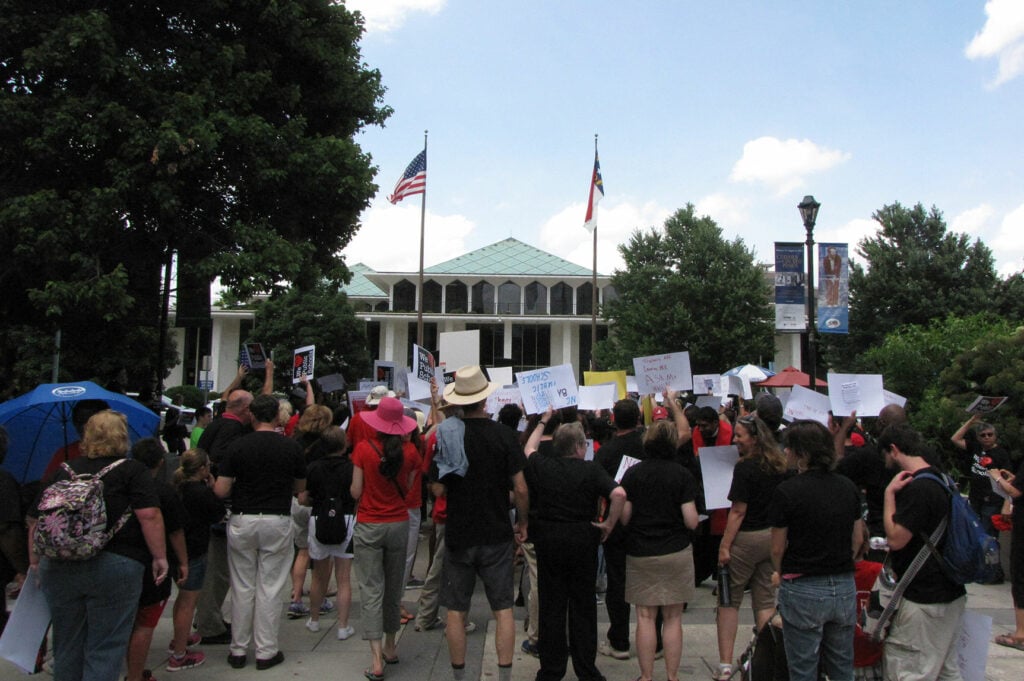U.S. Current Trend: New Restrictions on Protests at Statehouses
PUBLISHED: MARCH 2023
U.S. statehouses are a common venue for protests. State legislatures address critical issues that affect people’s daily lives, and state capitols are the natural destination for people to express their opinion to lawmakers. Capitol buildings and their surrounding grounds provide demonstrators with a public venue that is not only symbolic but also within the “sight and sound” of representatives who can act on their message and media that can amplify it.
In stark contrast to the violence that accompanied the January 6 breach of the U.S. Capitol, the overwhelming number of protests at state capitols are peaceful. Capitols in large states like Texas and California see hundreds of protests each year without incident on issues from access to clean water to women’s reproductive rights.
Yet the ability of individuals to participate in protests at this archetypal public forum is increasingly under threat. Across the country, governors and lawmakers are using various tools to limit, punish, and deter demonstrations at state capitols.

Visit our US Program page and US Freedom of Assembly page to learn more about this issue and explore additional resources. For more information on this issue, contact Elly Page at epage@icnl.org.
The most overt of these recent efforts have garnered national media attention: For instance, in April, lawmakers in Montana banned a transgender representative from the floor after she appeared to encourage protesters who were chanting against a bill to ban gender-affirming care for children. In Tennessee, lawmakers expelled two of their peers from the legislature for disrupting a floor session by joining protesters in the gallery who were demonstrating for gun control.
But officials are also deploying new laws and regulations to limit protests in and near statehouses. In Mississippi, a new law requires organizers to obtain permission from state law enforcement before they can protest near the capitol. Several civil rights groups have challenged the law as an unconstitutional constraint on free speech. New rules in Florida similarly require protesters at the state capitol to be approved by a state agency, mandate that protesters’ purpose align with the mission of the approving agency, and give law enforcement sweeping new power to remove protesters from the capitol building or grounds. These kinds of restrictions allow officials to selectively silence speech and limit statehouse access if they dislike protesters’ messages.
States have taken other approaches to limit protests around their capitols in recent years. Following a racial justice sit-in outside the capitol in 2020, Tennessee passed a sweeping anti-protest law that expanded the definition of “camping” and made it a felony offense to camp on state property. Utah enacted new criminal penalties—including possible jail time—for demonstrators who make “unreasonable noises” within earshot of lawmakers in session or other official meetings. In West Virginia, following a 2018 protest by thousands of public school teachers at the statehouse, the state adopted new legal protections for Capitol Police who injure or kill people in the course of dispersing an “unlawful assembly.” Lawmakers in Oklahoma proposed instituting a $50,000 bond requirement for organizers of statehouse protests to cover potential security or cleanup costs.
Efforts to limit protests at state capitols are part of a nationwide contraction of protest rights. Restricting protests at state capitols is particularly alarming given the importance of the statehouse as a venue for the public to communicate with elected officials. Instead of trying to silence such communication, government officials should facilitate it by protecting the public’s access to statehouses. Any restrictions on access should be based on a legitimate need, narrowly targeted, and applied in a nondiscriminatory manner. For instance, many states already have rules that allow members of the public to be removed if they significantly disrupt lawmakers’ work. Such limitations may be appropriate if they are narrowly drafted and do not contain disproportionate penalties.
Statehouses have long been essential sites of protest in the United States, and governors and legislators need to take steps to safeguard this proud tradition.
Sign up for our newsletters
Sign up